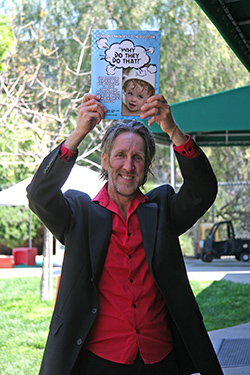
Paul Pitner
Paul Pitner, early childhood education professor at DVC, has published his third book about childhood education, along with Glenda Fuge, retired occupational therapist and former adjunct professor of occupational therapy at San Jose State University.
Pitner earned his BA degree in psychology from UC Berkeley, and an MA from San Francisco State University in teaching college psychology and child development. He has taught at DVC for 24 years, including 20 years part-time in both the Psychology and Early Childhood Education Departments, and four years as a full-time professor in early childhood education.
Fuge earned an MS in health education and is a registered and licensed occupational therapist. She continues to lecture, write and consult to various institutions, including private schools and fire departments across the nation.
Pitner and Fuge have been friends and colleagues for 25 years, worked together on a multidisciplinary team at Mills-Peninsula Hospital and ran self-esteem groups for children with cerebral palsy at Bridge School in Hillsborough, as well as lecturing and consulting reciprocally.
“Glenda suggested that we collaborate on writing a book that addressed common questions
regarding behavior in children 0 to 5 years old, both as a way to combine our expertise
and experience, and to spend time together
doing that.”
The inspiration for this book, Why Do They Do That? came in big part from Pitner’s niece, Katie, who is diagnosed with autism and spends a lot of time creating wonderful drawings. “We came up with the idea of writing a book that would help educators and parents understand common things that children do that are confusing as to why they do them, and also identify when these normal behaviors are extending into the area of extreme,” Pitner said. “I asked my students in the DVC Early Childhood Department, as well as teachers in the DVC Children’s Center, for questions they had with regard to children in order to generate a pool of questions from which we chose those to answer.
“We then used Katie’s drawings as illustrations for each question we answered in the book,” he explained.
The book is a hands-on reference for parents, other caregivers, and teachers, and takes a unique approach to children’s behaviors that often dismay and puzzle adults. Each behavior is presented on a two-page spread, with clear and easy-to-read sections such as Question-Plausible Answers (does it stem from social, sensory, or communication issues), Basic Training (suggestions for what to do), Over and Above (further ideas, who to consult in serious cases, etc), Red Flag (first signs that behavior needs attention), and What’s Next (possible follow-up).
He said the most fun they had in writing the book was “going through the vast collection of drawings that Katie had done to find the right one that captured the tone of the questions we were answering.”
On the other hand, he said, the hardest part was “limiting our answers and making
them concise. We have a lot of expertise in the areas of the physiological and psychological
understanding of children’s behavior, so putting our knowledge in a form that was
accessible was challenging. And coming up with communication-based explanations for
children’s behavior necessitated a lot of research, since we are not experts in that
field. Finally, truly the worst part of writing a book is the editing, as neither
Glenda nor myself has a lot of patience for doing the same
thing over and over again,” which is what you have to do to make sure the words and
sentence structure are right.
The book was published by AAPC publishing, which specializes in books about children with autism and related conditions. It is currently available at the publisher’s website: www.aapcpublishing.net, at Amazon.com, and will be available in the DVC Book Center in the fall.
Deya Brashears Hill, Ed.D., of Diablo Valley College, says of the book: “As a go-to resource, Why Do They Do That? provides valuable tools and insights for all those on the front lines of supporting children’s healthy development. Teachers and parents will find practical illustrations to promote research-based understanding of common and not-so-common behaviors.”
“What an honest, practical, and refreshing look at the behaviors that often puzzle or frustrate people who have young children in their lives!” says Suzette Handy, MAT, ECE professional development coordinator at DVC. “I have been looking for a book to use with parents and early childhood educators that describes real-life child behaviors and presents possibilities to consider in understanding and supporting children’s development. Why Do They Do That? is that book!”
“Raising a child, teaching child development, and working with a marvelous team of professionals at the beginning of my career inspired me to look at the whole child, both as a parent and a professional,” Pitner said. “I have to say that I have experienced all sides of the DVC ECE Department and the DVC Children’s Center. I have taught in it and worked closely with the professional staff who run the classrooms in the Children’s Center, and I can say without hesitation that they are the most knowledgeable, kind, and practiced professionals in early childhood education.
“My daughter went to the Center when she was a toddler and preschooler and it provided her with the foundation that has guided her through all of her education. It was Children’s Center staff who identified my daughter’s learning and speech difficulties and encouraged me to seek the interventions that have made a college experience possible for her all these years later. And it was the Center staff who provided many of the inspirational questions that Glenda and I used in the book.”

